Toshiba Satellite U845W Ultrabook Review: Going Wide at 21:9
by Dustin Sklavos on October 16, 2012 12:01 AM ESTOverall Performance
The Ivy Bridge CPU that beats at the heart of the Toshiba Satellite U845W isn't the fastest on the block, but it should certainly be adequate. Using a caching solution instead of a dedicated SSD is bound to hurt PCMark scores, but I did find in practice that it was a healthy step up from just having a straight mechanical hard disk in the system. You can at least feel the difference when using the U845W.
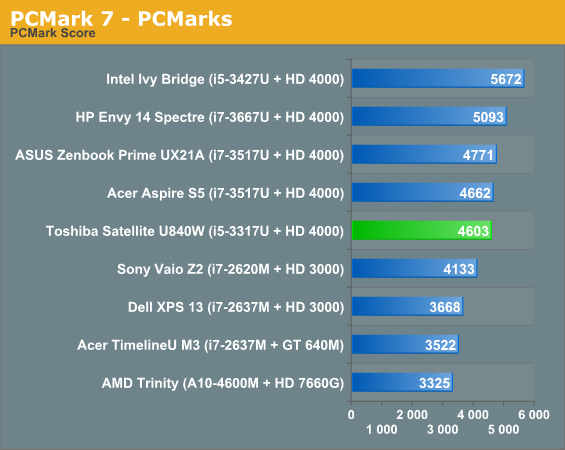
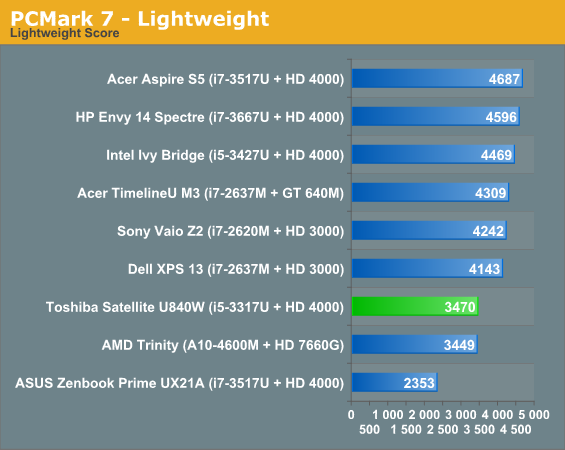
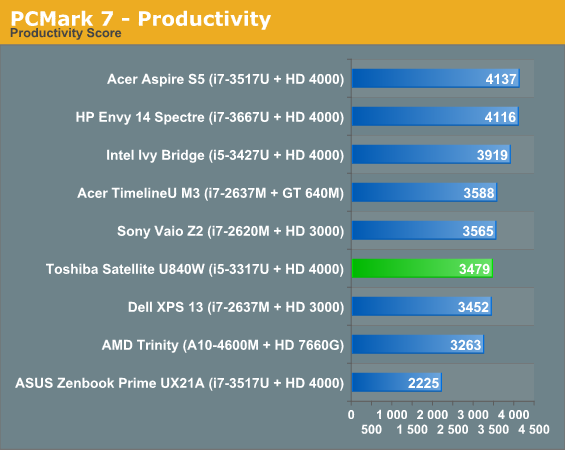
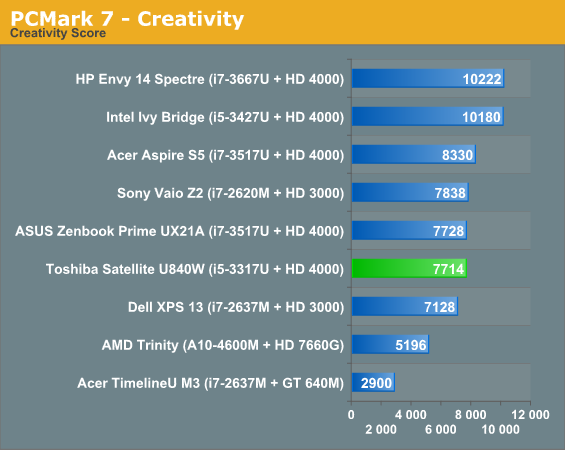
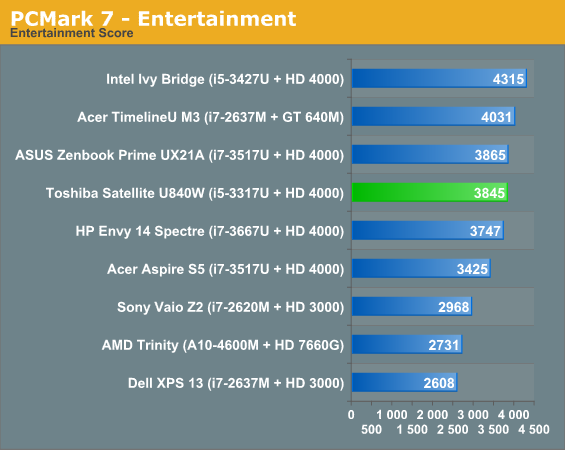
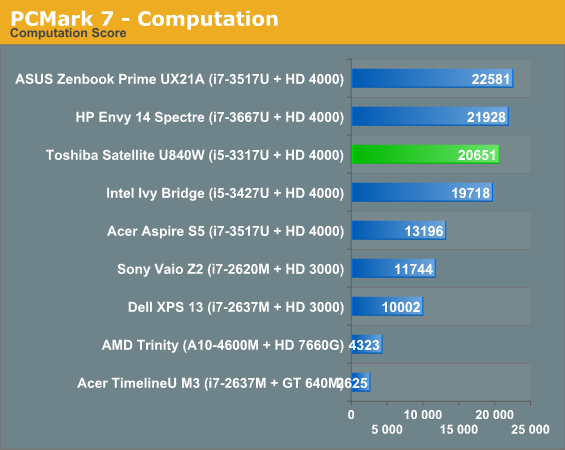
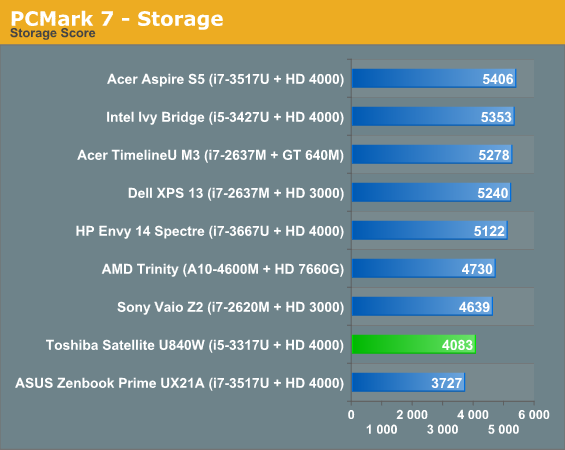
The lack of a dedicated SSD causes the U845W to jump around the charts a bit. PCMark Vantage should hopefully paint a clearer picture.
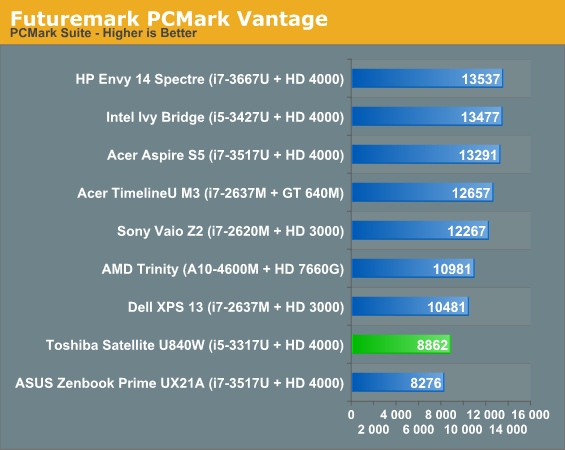
And there it is. Caching helps, but generally a dedicated SSD produces superior performance.
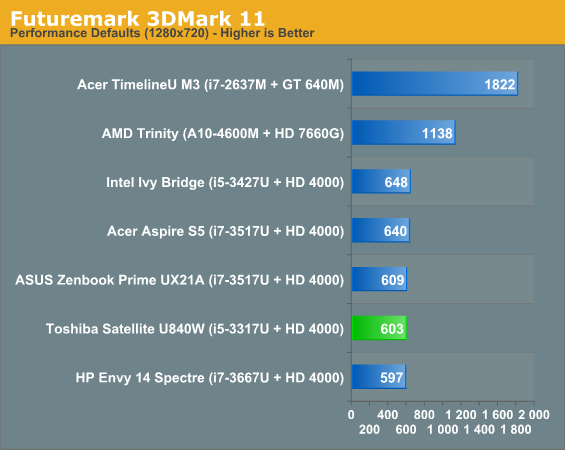
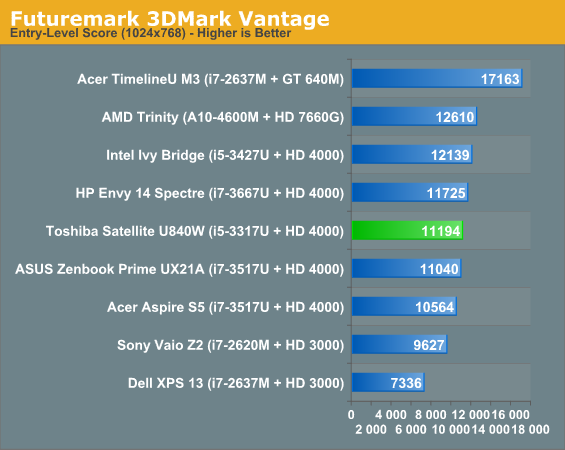

3DMark performance is pretty much where we'd expect it, even a bit better. As you'll see later on, Toshiba's thermal solution for the Satellite U845W is actually a very good one, and that extra thermal headroom is probably allowing the notebook to run in turbo modes for longer than some of the competing designs (as seen in 3DMark06).
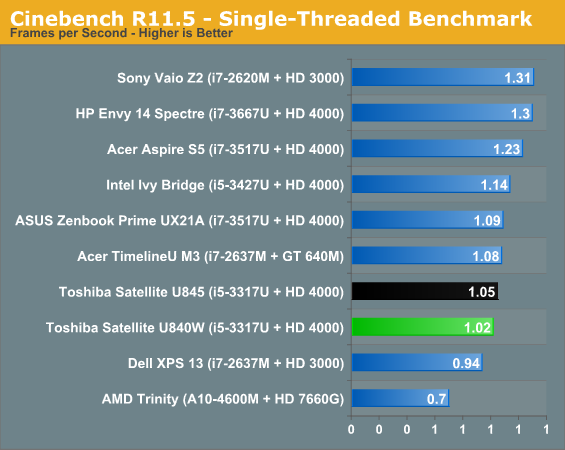
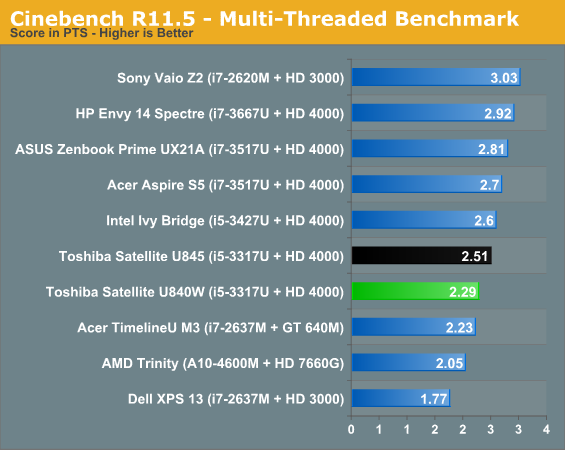
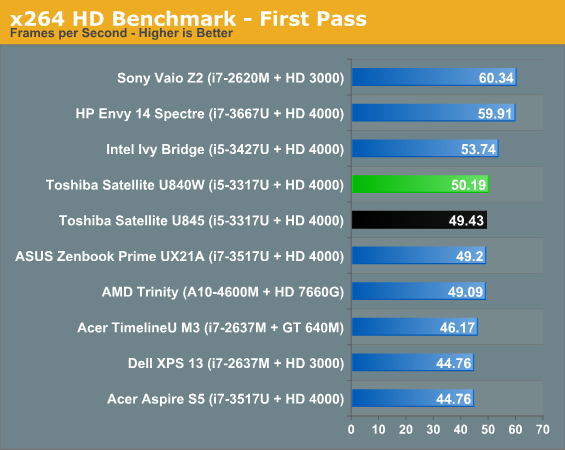
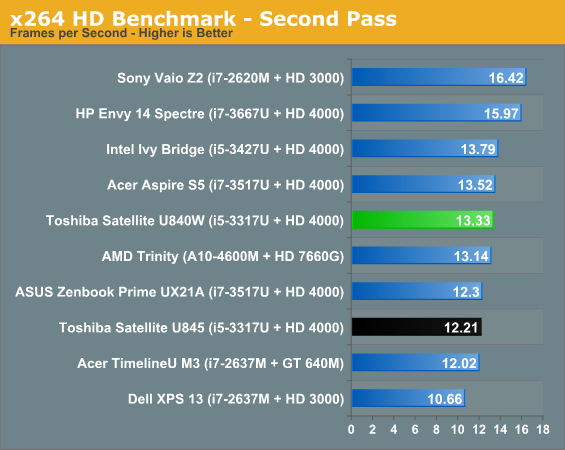
The Satellite U845W and comparable U845 produce fairly consistent scores and are cetainly capable enough notebooks.
While ordinarily I eschew doing gaming benchmarking on HD 4000-equipped systems unless we just don't have enough scores, I'm making an exception with the U845W. The reason is a simple one: the appeal of potentially gaming at a 21:9 resolution. I will say that subjectively games do look really cool on the U845W, and that makes the lack of a dedicated graphics solution a little heartbreaking.
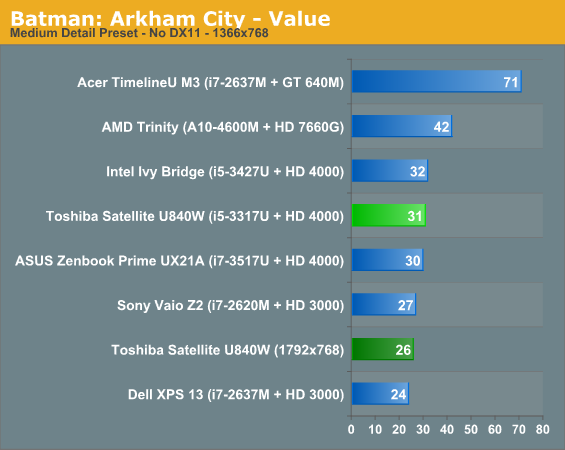
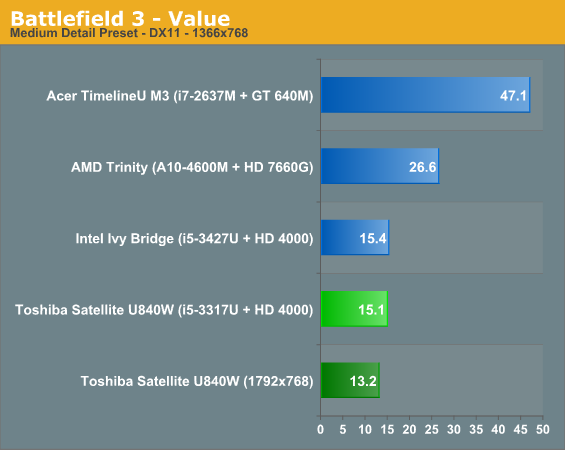
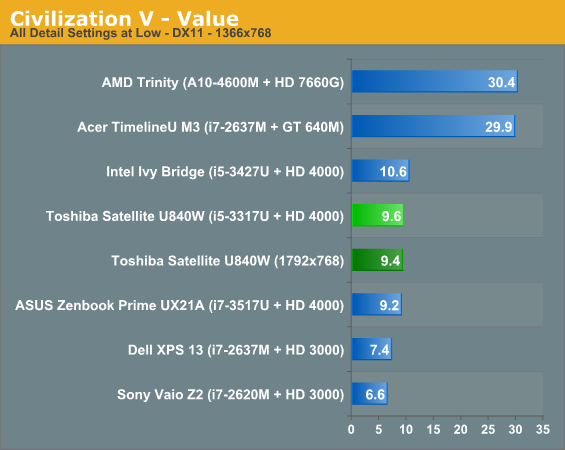
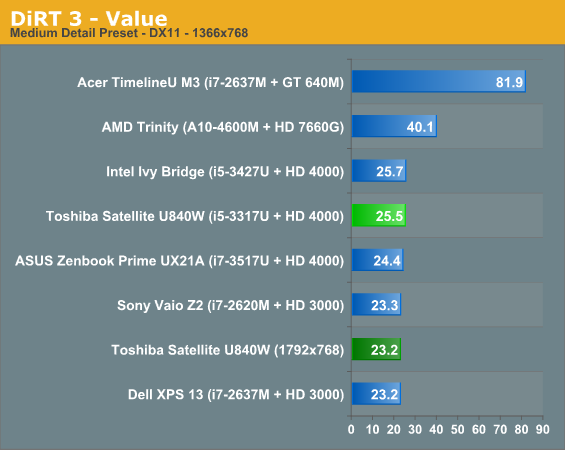
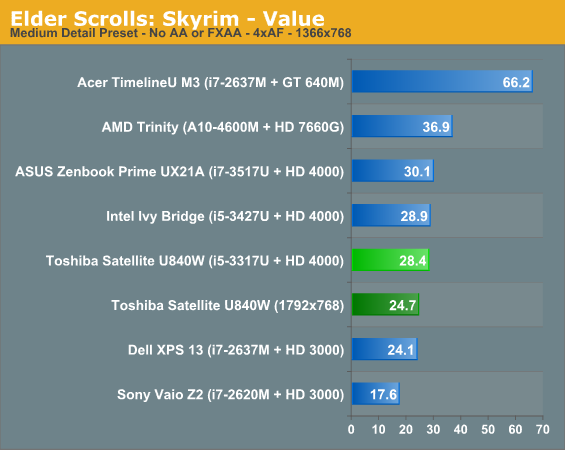
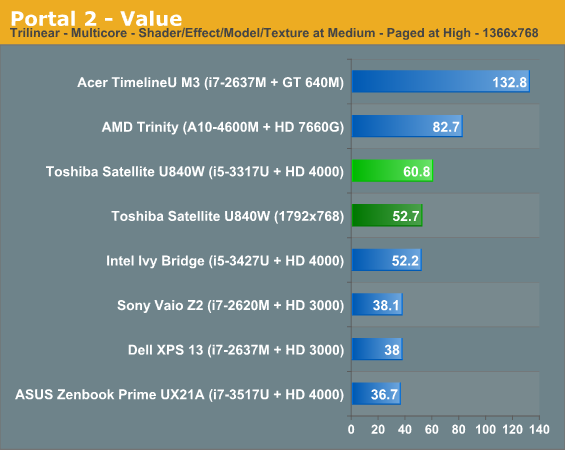
Only Portal 2 offers truly playable performance, but it's worth noting that the increase in resolution doesn't seem to hurt the Ivy Bridge GPU too badly. If you're willing to bring settings even further down, there's a good chance you can make a few of the games here playable. That means the HD 4000 in the U845W will certainly do in a pinch, but I'd love to see Toshiba come out with a model that has even a low end 28nm die-shrunk Fermi in it. Something with just a little more kick than the HD 4000.










57 Comments
View All Comments
processinfo - Tuesday, October 16, 2012 - link
Come on, now you can have all your icons pined to taskbar. They also removed a need for horizontal scrollbar. Maybe 45:9 would be even better (or 5:1 if you like).Kidding aside I agree this is horrible idea. Get us back 19:10 or 4:3 laptops!!
Kind of reminds me a joke about bus that was 30ft wide and only couple of feet long because everybody wanted to sit next to driver.
MobiusStrip - Tuesday, October 16, 2012 - link
It's time to move out of the '90s. Thunderbolt should be a standard item at this point.Streetwind - Tuesday, October 16, 2012 - link
There's one thing I am missing in this review, and that is a look at how the form factor affects portability.Ultrabooks are meant to be just that: ultraportable. They are meant to weigh little, fit in every pocket (figuratively), and easy to hold and handle, with one hand if necessary.
How does this form factor rest on the lap? Does it feel heavier, or more unwieldly in size, when compared to the regular 16:9 model? Does it fit into bags and backpacks just the same? What's the general feel of it in a day to day usage and carrying scenario?
I suppose it's a nice thing that this model has so much space to dedicate to cooling, but really: that space doesn't come out of nowhere. This thing is very large for an ultrabook, so the handling should be examined.
Calista - Tuesday, October 16, 2012 - link
The FW11E I'm using as a HTPC is 16" with a 16:9 aspect screen is roughly 1 cm wider than the U845W and it's very clumsy to bring along the few times I for one reason or another have to have it with me. And so I have to assume the U845W will be fairly clumsy as well even if it's both much thinner and lighter.The development we have had for the last few years saddens me. I guess 16:10 is workable, but from a portability and ergonomic point of view the old 4:3 format makes much more sense with one exception and that's among 12" laptops since they are small enough as is.
Obviously depending on what you do but I find a vertical resolution of 1600 (as in 30" at 2560x1600 or 20" at 1200x1600) to be the sweet spot even if 1050 is workable on a laptop. But 768 is a far cry from 1050 and even more so from 1600.
Avendit - Tuesday, October 16, 2012 - link
I had a toshiba libretto L1 (http://tinyurl.com/ck4f9yo) that got me through a lot of uni and a few coding jobs. 1200 x 600 wasn't ideal, but you could swap height for width with little effort. Tool bars on the side or floating, work full screen, autohide etc.The wide res really worked for coding - you could get long lines of code all on the screen, and the PPI of 1200 on a 10" screen was stunning. System was reasonably powerful for its day too (played quake!), just wish I'd been able to get a later version with onboard NIC.
Superwide can work, you just need to be willing to change your work habits a little. What worries me is the size of this - I don't think I would put up with such an odd screen res without some other compelling feature tho - at the time the L1 was a ~1kg laptop that appeared to sacrafice very little for its size, the screen was a resulting oddity that you learned to live with and like to some extent. At 2kg there are probably other alternatives that I'd want to try in person first.
Avendit
jabber - Tuesday, October 16, 2012 - link
...is because someone typed the wrong horizontal resolution number into a screen order and they ended up with 30000 non standard screens.As mentioned, though you get a machine with a odd feature as its main USP and the review doesn't even showcase it so we can see what the fuss is about.
You know some of us do care about other factors than pretty pointless benchmark graphs.
What next? Anandtech get a laptop in that has the ability to be used underwater yet it never leaves the testbench?
DanNeely - Tuesday, October 16, 2012 - link
I wish you were right. With Follywierd producing ever more content at 2.37:1; this is probably a trial balloon for the next step in degrading computer screen usability for anything except consuming their garbage.Mugur - Tuesday, October 16, 2012 - link
Maybe they should call it "Portable 2.35:1 Movie Player"... :-)Mugur - Tuesday, October 16, 2012 - link
Oh and it has ONLY USB 3.0, which means that most probably you cannot install Windows from a USB stick... It happened to me a few times when I accidentally plug the stick into a USB 3 port on various notebooks.xTRICKYxx - Tuesday, October 16, 2012 - link
Uhh, That shouldn't affect your installation. USB 3.0 is backwards compatible. I've installed Windows 7 on three notebooks using 3.0 ports and it went fine.